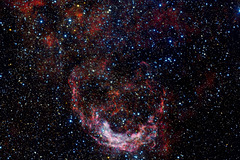Hungarian astronomers reveal the type of young star 9,200 light years from Earth

Photo: NASA
Hungarian astronomers have determined the possible nature of the Gaia20eae source, which is located at a distance of 9,200 light years from Earth and is characterized by significant fluctuations in brightness. According to the conclusions of scientists, the object belongs to unusual young stars – objects of the EX Lupi (EXor) type. This is reported in an article published in the arXiv preprint database.
Young stellar objects (YSOs) are stars that are in their early stages of evolution, that is, they are protostars or have recently entered the main sequence. YSOs are often surrounded by clouds of molecular gas and interstellar dust, so they attract matter from time to time, leading to increased flare activity. Young stars are divided into two types – FU Orionis (FUor) and EXor. The former can become brighter by four magnitudes and remain in this state for several decades, while the latter increase their activity for several months or years.
Astronomers have revealed that Gaia20eae, discovered in August 2020 by the Gaia spacecraft (owned by the European Southern Observatory, ESA), belongs to EXor. Scientists found that the increase in brightness began in early 2020 and continued, despite some variability, at an average rate of half a magnitude per month from January to July 2020. The peak was passed at the end of July 2020, and the star is currently losing its brightness at a rate of 0.25 magnitude per month. The resting level will be reached in May 2022.
Moreover, the rate of mass growth of Gaia20eae during the darkening phase is higher than that of typical T Tauri stars of similar mass, which also belong to YSO. The authors note that Gaia20eae may have achieved high accretion rates typical of some FUor. However, further research is needed for definitive conclusions.

